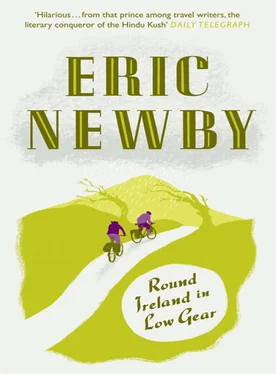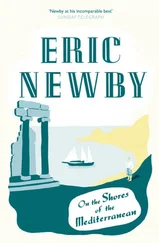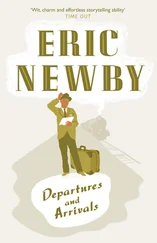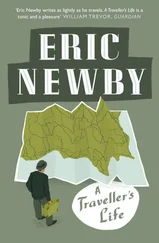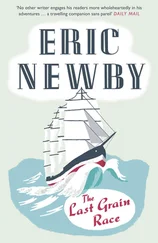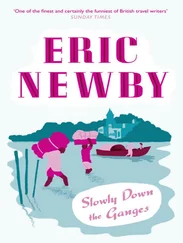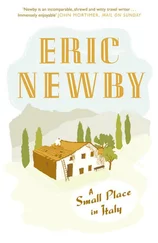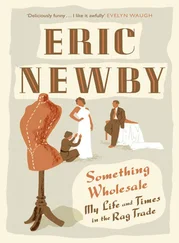We went to London to make the rounds of shops selling mountain bicycles, and if possible purchase some. Under the arches off the Strand, in the substructure which was all that remained of the Adelphi, the Adam brothers’ great riverside composition, we saw and rode our first mountain bikes. Wanda tried something called a Muddy Fox Seeker Mixte, which had an open frame constructed from Japanese fully lugged chrome molybdenum tubing with Mangaloy manganese alloy forks; I tried a Muddy Fox Pathfinder which had a lugless frame of the same material, put together by the TIG (Tungsten Inert Gas) welding process. Wanda quite liked her Mixte which reminded her a bit of the old Bianchi open-framed bike on which she had ridden out to bring me and my friends food and clothing in the autumn of 1943.
What the staff of most of the bicycle shops we visited had in common, we discovered, was almost complete indifference as to whether we bought one of their bikes or not. This was surprising, considering how much money was involved and the fact that the industry was going through one of its periodic slumps. In mountain bikes there was nothing worth buying under £200. From £200 to £300 the choice was very limited and it was only in the £300 to £500 range that one started to find high quality bikes. From £500 to around £1000 or more, one was in a world of prototypes and purely competitive machines in which everything, as the Buyer’s Bible put it in a way that I was beginning to find insidiously corrupting, was ‘silly money’. One thing we had learned was that whatever make we bought, our bikes should come from a firm that actually built, or at least assembled them, on the premises. But time was now running out and if we did not leave for Ireland within ten days we would have to wait until after Christmas. One of the firms we had not yet visited was called Overbury’s, in Bristol, who designed and built their own racing, touring and mountain bikes. And Bristol had the added attraction that our daughter, son-in-law and grandchildren lived there.
Overbury’s premises, in Ashley Road, can scarcely be described as being at ‘the better end’ of Bristol; in fact Bristol has no better end. The more enviable parts are perched high above the city at the top of impossibly steep hills or on huge cliffs above the Avon Gorge, from both of which eyries the inhabitants look down with Olympian detachment on those less fortunate mortals below. Overbury’s, which is run by Andy Powell and his mother, Enid, is about the size of an average newsagent’s and is crammed with bikes that are either beautiful or sophisticated, or both, and all the complex bits and pieces that go to make them up. What space remains is taken up by machines in various states of malfunction or collapse awaiting attention. In fact on the Monday morning we visited, it was rather like being in a National Health doctor’s waiting room during surgery hours. One of the more spectacular accidents had befallen an ATB -riding log-hopper who had failed to clear a huge pile of them in a Forestry Commission conifer wood. The resulting smash had destroyed the special welded guard bar, fitted under the bottom bracket to protect the triple chain rings from just such a mishap, doing a wealth of damage.
‘You’re looking at more than a hundred nicker,’ the owner said with gloomy pride, when I showed an interest in it. ‘That’s the end of guards for me.’
We were lent a couple of test bikes on deposit and we set off with them in the back of our van for an attractive open expanse called Ashton Court Park, to try them out. Wanda’s was the most expensive and the most unconventional in appearance. It was called the Wild Cat and was going to take a bit of living up to.
Mine was a Crossfell, at that time the most expensive of Overbury’s diamond frame mountain bikes.
By the end of this outing Wanda was very depressed. It was not surprising: the last bicycle she had ridden had been a borrowed ladies’ Marston Golden Sunbeam which she had used while house-hunting in South London in the 1970s, perhaps the finest conventional bicycle ever made. This was the bicycle on male versions of which deceptively fragile-looking curates used to zoom past me, as I frantically pedalled my Selbach back in the 1930s. She liked the semi-open frame of the Wild Cat, but found it difficult to live up to the image conjured up by its name. She couldn’t cope with the complexity of the twin-change shift mechanisms on the handlebars which controlled the eighteen gears: the right-hand one which shifted the chain from any one of the six sprockets to another on the Shimano Extra Duty Freewheel Block; the left-hand one which shifted the chain on the costly oval Shimano Biopace triple ring chainset. ‘Biopace delivers power when you need it most,’ the blurb said. ‘Computer analysis shows round rings force unnatural leg dynamics that interfere with smooth cadence and can lead to knee strain.’
In comparison with a traditional lightweight bicycle fitted with narrow, high-pressure tyres I found the knobbly mountain tyres sluggish uphill, but very good downhill at speed on a track full of pot-holes. The saddles, amalgams of leather and plastic, we both agreed were hell. By the time our trial run through the wilds of the Ashton Court Park was over I had resigned myself to giving up the idea of mountain biking, or any other sort of biking, in Ireland; but when we got back to the shop and redeemed our deposits Wanda, to my surprise, told me to go ahead and order. ‘If I have it I will have to use it,’ she said.
There was no problem in producing my Crossfell in time, as there was a frame in stock of the right size that only needed stove enamelling. Wanda’s Wild Cat, as its name suggested, was more difficult. It would have to be built from scratch in seven days. But first her inside leg had to be measured for the frame – a feat difficult to accomplish in a crowded bike shop when the subject is wearing a skirt – and all work ceased while I performed it.
In a state of shock at the realization of the enormity of what I was doing I allowed Andy Powell to persuade me that I should also have eighteen gears. I forget the reason he gave. Perhaps he had run out of five-sprocket freewheel blocks, the last shipment from Osaka having gone down with all hands in the South China Sea to become a source of wonder to marine archaeologists around 3000 AD, who would eventually identify them as amulets against the evil eye.
In the course of the next hour or so I spent vast amounts of money – we paid for everything ourselves – on what bicycle builders laughingly refer to as ‘optional extras’: pumps, front and rear reflectors, guards to protect the derailleur mechanisms, frame pads to make it easier to lift my diamond-framed Crossfell over gates and fences, over-sized mud guards for the over-sized tyres, two sets of front and rear panniers, front and rear pannier frames to hook them on, ‘stuff sacs’, rudely named bags to keep our waterproof clothing in, front and rear lights, drinking bottles, Sam Browne belts and trouser clips made of reflective material that might improve our chance of not being knocked down and squashed flat at night. Foolishly, having donned them and then looked at one another, we decided against crash helmets – ‘head protection for the thinking cyclist’, as one catalogue put it.
We also needed a whole lot of tools and spares: a three-way spanner, a ten-in-one dumbell spanner, two brake spanners, a pair of cone spanners, a Shimano crank bolt spanner and freewheel remover, a 4″ adjustable wrench, three Allen keys, a spoke key, a cable cutter, a pair of pointed pliers, a tyre pressure gauge, an adaptor so that a garage air-line or a car foot pump could be used with Presta bicycle valves, a set of tyre levers, spare spokes, two spare inner tubes, spare gear change and brake cables, spare brake blocks (at a colossal £3.90 a pair), and valve caps.
Читать дальше
